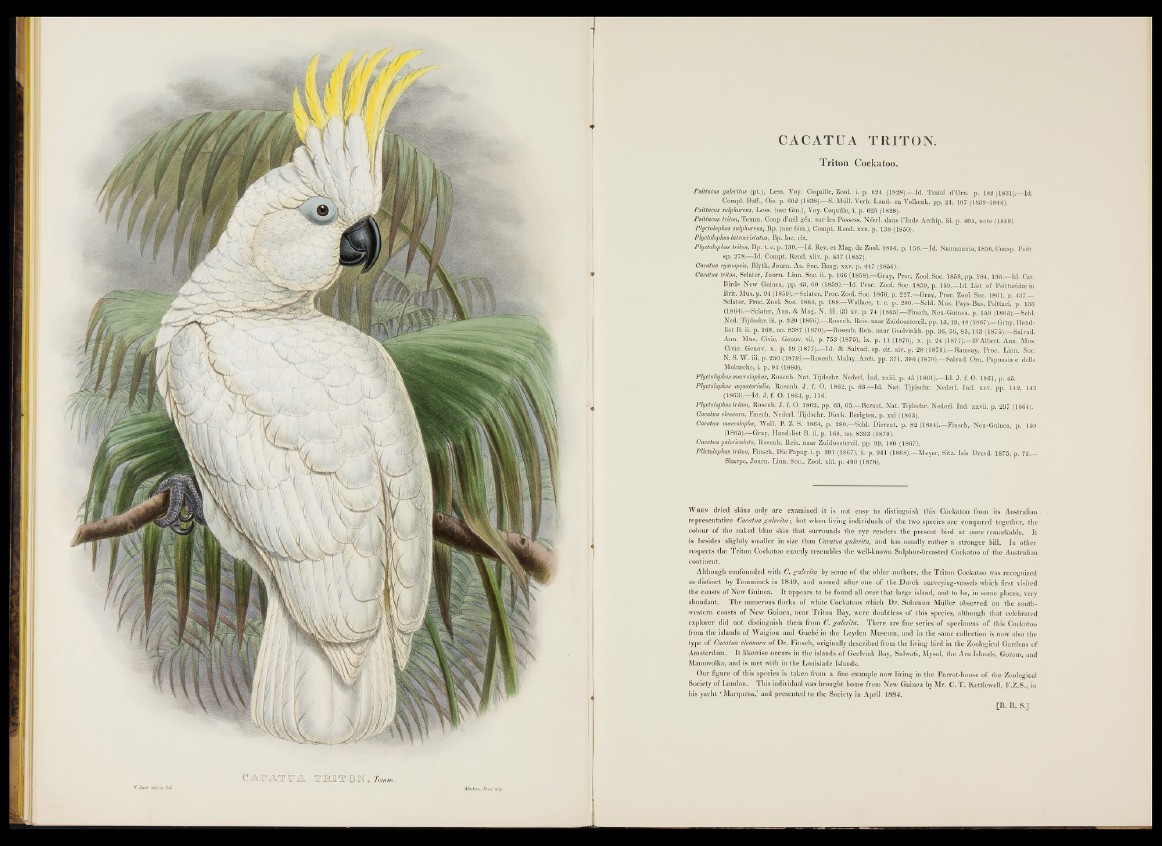
C A . C A T K T A T J & I I 0 M , Temm.
CACATUA TRITON.
Triton Cockatoo.
Psittacus galeritus (pt.), Less. Voy. Coquille, Zool. i. p. 624 (1828).—Id. Traité d'Orn. p. 182 (1831).—Id.
Compl. Buff., Ois. p. 602 (1838).—S. Miill. Verh. Land- en Volkenk. pp. 21, 107 (1839-1844).
Psittacus sulphureus, Less, (nec Gm.), Voy. Coquille, i. p. 625 (1828).
Psittacus triton, Temm. Coup d’oeil gén. sur les Possess. Néerl. dans l’Inde Archip. iii. p. 405, note (1849).
Plyctolophus sulphureus, Bp. (nec Gm.), Compt. Rend. xxx. p. 138 (1850) .
Plyctolopkus luteocristatus, Bp. loc. cit.
Plyctolophus triton, Bp. t. c. p. 139.— Id. Rev. e t Mag. de Zool. 1854, p. 156.—Id. Naumannia, 1856, Consp. Psitt.
sp. 278.—Id. Compt. Rend. xliv. p. 537 (1857).
Cacatua cyanopsis, Blyth, Journ. As. Soc. Beng. xxv. p. 447 (1856).
Cacatua triton, Sclater, Journ. Linn. Soc. ii. p. 166 (1858).—Gray, Proc. Zool. Soc. 1858, pp. 184, 195.—Id. Cat.
Birds New Guinea, pp. 43, 60 (1859).—Id. Proc. Zool. Soc. 1859, p. 159.—Id. List of Psittacidæ in
Brit. Mus. p. 94 (1859).—Sclater, Proc. Zool. Soc. 1860, p. 227.—Gray, Proc. Zool. Soc. 1861, p. 437.—
Sclater, Proc. Zool. Soc. 1864, p. 188.—Wallace, t. c. p. 280.—Schl. Mus. Pays-Bas, Psittaci, p. 133
(1864).—Sclater, Ann. & Mag. N. H. (3) xv. p. 74 (1865).—Finsch, Neu-Guinea, p. 159 (1865).—Schl.
Ned. Tijdschr. iii. p. 320 (1866),—Rosenb. Reis. naar Zuidoostereil. pp. 13,19, 48 (1867).- Gray, Handlist
B. ii. p. 169, no. 8387 (1870).—Rosenb. Reis. naar Geelvinkb. pp. 36, 56, 83, 113 (1875).—Salvad.
Ann. Mus. Civic. Genov, vii. p. 753 (1875), ix. p. 11 (1876), x. p. 24 (1877).—D’Albert. Ann. Mus.
Civic. Genov, x. p. 19 (1877),— Id. & Salvad. op. cit. xiv. p. 28 (1879).—Ramsay, Proc. Linn. Soc.
N. S. W. iii. p. 250 (1879),—Rosenb. Malay. Arch. pp. 371, 396 (1879).—Salvad. Orn. Papuasia e delle
Molucche, i. p. 94 (1880).
Plyctolophus macrolophus, Rosenb. Nat. Tijdschr. Nederl. Ind. xxiii. p. 45 (1861).—Id. J. f. O. 1861, p. 45.
Plyctolophus eequatorialis, Rosenb. J. f. O. 1862, p. 63.— Id. Nat. Tijdschr. Nederl. Ind. xxv. pp. 142, 143
(1863).—Id. J . f. O. 1864, p. 116.
Plyctolophus triton, Rosenb. J. f. O. 1862, pp. 63, 65.— Bernst. Nat. Tijdschr. Nederl. Ind. xxvii. p. 297 (1864).
Cacatua eleonora, Finsch, Nederl. Tijdschr. Dierk. Berigten, p. xxi (1863).
Cacatua macrolopha, Wall. P. Z. S. 1864, p. 280.—Schl. Dierent. p. 82 (1864).—Finsch, Neu-Guinea, p. 159
(1865).—Gray, Hand-list B. ii. p. 169, no. 8393 (1870).
Cacatua galericulata, Rosenb. Reis. naar Zuidoostereil. pp. 99, 100 (1867).
Plictolophus triton, Finsch, Die Papag. i. p. 291 (1867), ii. p. 941 (1868).—Meyer, Sitz. Isis Dresd. 1875, p. 75.—
Sharpe, Journ. Linn. Soc., Zool. xiii. p. 490 (1878). :
W h e n dried skins only are examined it is not easy to distinguish this Cockatoo from its Australian'
representative Cacatua galerita; but when living individuals of the two species are compared together, the
colour o f the naked blue skin th at surrounds the eye renders the present bird a t once remarkable. It
is besides slightly smaller in size than Cacatua galerita, and has usually rath er a stronger bill. In other
respects the Triton Cockatoo exactly resembles the well-known Sulphur-breasted Cockatoo o f the Australian
continent.
Although confounded with C. galerita by some o f the older authors, the Triton Cockatoo was recognized
as distinct by Temminck in 1849, and named after one o f the Dutch surveying-vessels which first visited
the coasts of New Guinea. I t appears to be found all over that large island, and to be, in some places, very
abundant. T h e numerous flocks o f white Cockatoos which Dr. Solomon Muller observed on the southwestern
coasts o f New Guinea, near Triton Bay, were doubtless o f this species, although that celebrated
explorer did not distinguish them from C. galerita. There are fine series o f specimens o f this Cockatoo
from the islands o f Waigiou and Guebe in the Leyden Museum, and in the same collection is now also the
type of Cacatua eleonora o f D r. Finsch, originally described from the living bird in the Zoological Gardens of
Amsterdam. It likewise occurs in the islands o f Geelviuk Bay, Salwati, Mysol, the Aru Islands, Gorarn, and
Manuwolka, and is met with in the Louisiade Islands.
O u r figure o f this species is taken from a fine example now living in the Parrot-house o f the Zoological
Society o f London. This individual was brought home from New Guinea by M r. C. T . Kettlewell, F.Z.S., in
his yacht ‘ Marquesa,’ and presented to the Society in April 1884.